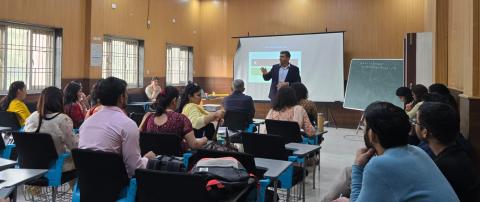
Between Rhyme and Reality: Rethinking Experiential Learning
This week I had the opportunity to speak to a group of educators on experiential learning. They are the key resource persons and will further train teachers from across Delhi on NEP.
To start the session, I shared my learning from one of the experiences in the schools I visited recently. We started singing a nursery rhyme together Chakai ke Chak Dum, and each participant had to add a line in tandem with the rhythm of the song. The line I added was “Chalo milke ped pe chadhna sikhe hum tum,” and several interesting lines were added by the participants. We were standing in a round circle, we all sang, and while singing we also snapped our fingers. My colleagues also clicked pictures. The activity group looked great—participative and ‘experiential’.
Later, while I was thinking, I found that in the name of experiential learning what we are doing is not more than tokenism. Before modern schooling, most learning was almost experiential; we learned by engaging in authentic projects alongside our elders. I also proposed (and I may be wrong) that whatever we call learning is basically experiential—what we carry with ourselves in the form of knowledge and disposition. All that is non-experiential ends with the exam.
However, the way experiential learning is integrated in day-to-day school practices appears to me more like a token than something authentic. When a child is engaged in pottery making, and the livelihood of the family depends on pottery and its sale, then how that child performs in pottery making becomes authentic because the stake is involved. But when the same activity becomes a project in school, good or bad pottery making will only result in a little increase or decrease in the marks awarded. This is still experiential, but the stake is not involved, and in that sense, this is not authentically experiential.
What Gandhi proposed through Nai Talim was the idea of authentic experiential learning. Similar patterns appear across thought leaders in the field—their idea of experiential learning is deeply connected to authentic settings, whether it is John Dewey, one of the greatest proponents of experiential learning, or A.S. Neill in the UK. Even some schools in India guided by the philosophies of Krishnamurti and Aurobindo try to bring authentic learning settings into the school.
With limited resources, growing pressure of completing syllabus and competitive exams, and therefore the race for numbers—is there space in our schools to promote experiential learning? Or will we continue with tokenism, where students keep making projects using cardboard, clay, and so on?
I proposed that the way schools are designed, it may not always be possible to create authentic settings for experiential learning. But what if we consider how a child lives in family and community as a setting for learning? For instance, in my classroom, we invested significant time discussing the lived realities of the children. It was a compulsory ritual for the children to write one page on what they see, feel, live, imagine, and experience. And then together we discussed those write-ups.
Can this be called experiential learning? Does it fulfil the criteria of an authentic setting for experiential learning? What could be other ways to bring experiential learning into the classroom that go beyond tokenism?
- Log in to post comments
